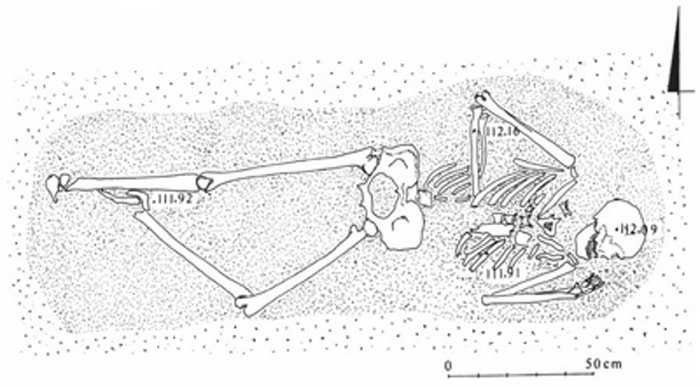Skeleton Of Medieval Giant Woman Discovered In Poland – Now Examined
– In 1977, archaeologists discovered a skeleton of a Medieval giant woman outside the church of the Ostrów Lednicki in Poland.
The woman was 7-foot-2-inches (2.155 meters) and had an oversized head. She died at a young age and and suffered from traumatic injuries and disease.

Now, scientists have examined the skeleton of the Medieval giantess and can offer more information about her life.
In the book New Developments in the Bioarchaeology of Care, archaeologists Magdalena Matczak and Tomasz Kozlowski present the results of the scientific studies and attempt to recreate the life of the Medieval female giant.
Ostrów Lednicki is an important early medieval archaeological site located 36 km from Poznan and about 18 km from Gniezno.
The remains of Ostrów Tumski are located on a lake island a half-hour drive away from Poznan and include the palace, a church and fortifications. The island has been inhabited since the late Stone Age. The ancient ruins are shrouded in myths and legends. One intriguing ancient story tell about an unknown king who rests together with his knights at the bottom of the lake.
The cemetery at the medieval church of the Ostrów Lednicki was initially used as resting place for the wealthiest people, often connected with Boleslaw the Brave, the King of Poland in the early 11th century, and with the local Piast ruling dynasty.
Later, in the 12th century the situation changed and the cemetery was used by the middle and lower class.
The giant woman discovered by archaeologists was a member of the lower class and she certainly did not receive a proper burial. She was tossed into the grave and her arms and legs sprawled in all directions.
While all other burials in the cemetery were made with the head facing west, this woman’s head was facing in the opposite direction.
“’The unusual burial orientation, disposal of the body without care, and lack of grave goods may indicate that this woman belonged to a lower social stratum,” Magdalena Matczak said.
Based on what researchers know, the woman died in her late 20s. She suffered from gigantism, a condition caused by an over-production of growth hormone from the pituitary gland.
She also suffered from acromegaly, a condition that makes the bones of the head particularly large. Sometime during her lifetime she broke an arm and leg. This could have happened because she had weak bones.
According to bioarchaeologists Judyta Julia Gładykowska-Rzeczycka, Anna Wrzesińska, and Anna Sokół, examination of the woman’s spine revealed evidence of degenerative joint disease, which was probably a result of her height and body weight.
Based on what we know today, write the Polish experts it is also reasonable to assume that the woman also suffered from anxiety, anger, mood swings and mental disorders.
Life must have been very difficult for the poor woman, but she wasn’t an outcast and there were people who cared about her.
The fracture on her leg had healed completely thanks to medical help she received from someone.
People with gigantism are well-known throughout history. Robert Pershing Wadlow, also known as the Giant of Illinois was the tallest man who ever lived. Another person worth mentioning is Chang Woo Gow, the kind and intelligent Chinese giant who first began showing himself in London around 1865.
Chang Woo Gow was not the tallest in his family, however, for one sister measured eight feet four inches.



 Creators of mankind
Creators of mankind Description of “Tall white aliens”
Description of “Tall white aliens” Where they came from?
Where they came from? About hostile civilizations
About hostile civilizations The war for the Earth
The war for the Earth “Tall white aliens” about eternal life
“Tall white aliens” about eternal life Video: “Nordic aliens”
Video: “Nordic aliens” Aliens
Aliens Alien encounters
Alien encounters The aliens base
The aliens base UFO
UFO Technology UFO
Technology UFO Underground civilization
Underground civilization Ancient alien artifacts
Ancient alien artifacts Military and UFO
Military and UFO Mysteries and hypotheses
Mysteries and hypotheses Scientific facts
Scientific facts


















